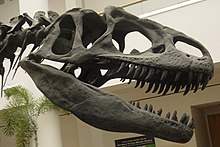Allosauroidea
| Allosauroids Temporal range: Middle Jurassic–Late Cretaceous, 175.6–91 Ma PreЄ Є O S D C P T J K Pg N | |
|---|---|
 | |
Allosaurus fragilis skull, San Diego Natural History Museum | |
Scientific classification | |
| Kingdom: | Animalia |
| Phylum: | Chordata |
Clade: | Dinosauria |
| Order: | Saurischia |
| Suborder: | Theropoda |
| Infraorder: | †Carnosauria |
| Superfamily: | †Allosauroidea Marsh, 1878 |
Type species | |
†Allosaurus fragilis Marsh, 1877 | |
| Subgroups[1] | |
| |
Allosauroidea is a superfamily or clade of theropod dinosaurs which contains four families — the Metriacanthosauridae, Allosauridae, Carcharodontosauridae, and Neovenatoridae. The oldest-known allosauroid, Shidaisaurus jinae, appeared in the early Middle Jurassic (probably Bajocian stage) of China. The last known definitive surviving members of the group died out around 93 million years ago in Asia (Shaochilong) and South America (Mapusaurus), though the megaraptorans, including the late-surviving Orkoraptor of the Late Cretaceous (Maastrichtian stage), may belong to the group as well. Additional, but highly fragmentary, remains probably belonging to carcharodontosaurids have been found from the Campanian-Maastrichtian boundary (70-66 Ma ago) in Brazil.[2] Allosauroids had long, narrow skulls, large orbits, three-fingered hands, and usually had "horns" or ornamental crests on their heads. The most famous and best understood allosauroid is the North American genus Allosaurus.
Contents
1 Classification
2 CPT-1980
3 See also
4 References
Classification

Allosauroidea skull comparison

The cladogram of the classification of Allosauroidea
The clade Allosauroidea was originally proposed by Phil Currie and Zhao (1993; p. 2079), and later used as an undefined stem-based taxon by Paul Sereno (1997). Sereno (1998; p. 64) was the first to provide a stem-based definition for the Allosauroidea, defining the clade as "All neotetanurans closer to Allosaurus than to Neornithes." Kevin Padian (2007) used a node-based definition, defined the Allosauroidea as Allosaurus, Sinraptor, their most recent common ancestor, and all of its descendants. Thomas R. Holtz and colleagues (2004; p. 100) and Phil Currie and Ken Carpenter (2000), among others, have followed this node-based definition. However, in some analyses (such as Currie & Carpenter, 2000), the placement of the carcharodontosaurids relative to the allosaurids and sinraptorids is uncertain, and therefore it is uncertain whether or not they are allosauroids (Currie & Carpenter, 2000).
The cladogram presented here is simplified after the 2012 analysis by Carrano, Benson and Sampson after the exclusion of three "wildcard" taxa Poekilopleuron, Xuanhanosaurus and Streptospondylus.[1]
.mw-parser-output table.cladeborder-spacing:0;margin:0;font-size:100%;line-height:100%;border-collapse:separate;width:auto.mw-parser-output table.clade table.cladewidth:100%.mw-parser-output table.clade tdborder:0;padding:0;vertical-align:middle;text-align:center.mw-parser-output table.clade td.clade-labelwidth:0.8em;border:0;padding:0 0.2em;vertical-align:bottom;text-align:center.mw-parser-output table.clade td.clade-slabelborder:0;padding:0 0.2em;vertical-align:top;text-align:center.mw-parser-output table.clade td.clade-barvertical-align:middle;text-align:left;padding:0 0.5em.mw-parser-output table.clade td.clade-leafborder:0;padding:0;text-align:left;vertical-align:middle.mw-parser-output table.clade td.clade-leafRborder:0;padding:0;text-align:right
Allosauroidea |
| ||||||||||||||||||
| |
CPT-1980
CPT-1980 is the museum catalog number for an isolated, 9.83 centimetres (3.87 in), allosauroid tooth crown currently housed at the Museo Fundación Conjunto Paleontológico de Teruel.[3] In 2009, the tooth was compared to another allosauroid tooth from Portugal that measured 12.7 centimetres (5.0 in). Analysis led to the conclusion that CPT-1980 is the largest theropod tooth ever discovered in Spain. This tooth was discovered by locals near Riodeva, Teruel in the Villar del Arzobispo Formation, more specifically known as RD-39. The rocks have been dated to the Tithonian-Berriasian stages (Late Jurassic-Early Cretaceous).[3]
See also
 Allosauroidea portal
Allosauroidea portal
References
Wikispecies has information related to Allosauroidea |
^ ab Carrano, M. T.; Benson, R. B. J.; Sampson, S. D. (2012). "The phylogeny of Tetanurae (Dinosauria: Theropoda)". Journal of Systematic Palaeontology. 10 (2): 211–300. doi:10.1080/14772019.2011.630927..mw-parser-output cite.citationfont-style:inherit.mw-parser-output .citation qquotes:"""""""'""'".mw-parser-output .citation .cs1-lock-free abackground:url("//upload.wikimedia.org/wikipedia/commons/thumb/6/65/Lock-green.svg/9px-Lock-green.svg.png")no-repeat;background-position:right .1em center.mw-parser-output .citation .cs1-lock-limited a,.mw-parser-output .citation .cs1-lock-registration abackground:url("//upload.wikimedia.org/wikipedia/commons/thumb/d/d6/Lock-gray-alt-2.svg/9px-Lock-gray-alt-2.svg.png")no-repeat;background-position:right .1em center.mw-parser-output .citation .cs1-lock-subscription abackground:url("//upload.wikimedia.org/wikipedia/commons/thumb/a/aa/Lock-red-alt-2.svg/9px-Lock-red-alt-2.svg.png")no-repeat;background-position:right .1em center.mw-parser-output .cs1-subscription,.mw-parser-output .cs1-registrationcolor:#555.mw-parser-output .cs1-subscription span,.mw-parser-output .cs1-registration spanborder-bottom:1px dotted;cursor:help.mw-parser-output .cs1-ws-icon abackground:url("//upload.wikimedia.org/wikipedia/commons/thumb/4/4c/Wikisource-logo.svg/12px-Wikisource-logo.svg.png")no-repeat;background-position:right .1em center.mw-parser-output code.cs1-codecolor:inherit;background:inherit;border:inherit;padding:inherit.mw-parser-output .cs1-hidden-errordisplay:none;font-size:100%.mw-parser-output .cs1-visible-errorfont-size:100%.mw-parser-output .cs1-maintdisplay:none;color:#33aa33;margin-left:0.3em.mw-parser-output .cs1-subscription,.mw-parser-output .cs1-registration,.mw-parser-output .cs1-formatfont-size:95%.mw-parser-output .cs1-kern-left,.mw-parser-output .cs1-kern-wl-leftpadding-left:0.2em.mw-parser-output .cs1-kern-right,.mw-parser-output .cs1-kern-wl-rightpadding-right:0.2em
^ Fernandes de Azevedo, R. P.; Simbras, F. M.; Furtado, M. R.; Candeiro, C. R. A.; Bergqvist, L. P. (2013). "First Brazilian carcharodontosaurid and other new theropod dinosaur fossils from the Campanian–Maastrichtian Presidente Prudente Formation, São Paulo State, southeastern Brazil". Cretaceous Research. 40: 131–142. doi:10.1016/j.cretres.2012.06.004.
^ ab Royo-Torres, R.; Cobos, A.; Alcalá, L. (2009). "Diente de un gran dinosaurio terópodo (Allosauroidea) de la Formación Villar del Arzobispo (Titónico-Berriasiense) de Riodeva (España)" [Tooth of a large theropod dinosaur (Allosauroidea) from the Villar del Arzobispo formation (Tithonian-Berriasian) of Riodeva (Spain)]. Estudios Geológicos (in Spanish). 65 (1): 91–99. doi:10.3989/egeol.39708.049.
Currie, P. J.; Zhao, X. (1993). "A new carnosaur (Dinosauria, Theropoda) from the Upper Jurassic of Xinjiang, People's Republic of China". Canadian Journal of Earth Sciences. 30 (10): 2037–2081. doi:10.1139/e93-179.- Holtz, T. R., Jr. and Osmólska H. 2004. Saurischia; pp. 21–24 in D. B. Weishampel, P. Dodson, and H. Osmólska (eds.), The Dinosauria (2nd ed.), University of California Press, Berkeley.
Sereno, P. C. (1997). "The origin and evolution of dinosaurs". Annual Review of Earth and Planetary Sciences. 25: 435–489. doi:10.1146/annurev.earth.25.1.435.
Sereno, P. C. (1998). "A rationale for phylogenetic definitions, with application to the higher-level taxonomy of Dinosauria". Neues Jahrbuch für Geologie und Paläontologie, Abhandlungen. 210: 41–83.
Fernandes De Azevedo, Rodrigo P.; Simbras, Felipe Medeiros; Furtado, Miguel Rodrigues; Candeiro, Carlos Roberto A.; Bergqvist, Lílian Paglarelli (2013). "First Brazilian carcharodontosaurid and other new theropod dinosaur fossils from the Campanian–Maastrichtian Presidente Prudente Formation, São Paulo State, southeastern Brazil". Cretaceous Research. 40: 131–142. doi:10.1016/j.cretres.2012.06.004.









